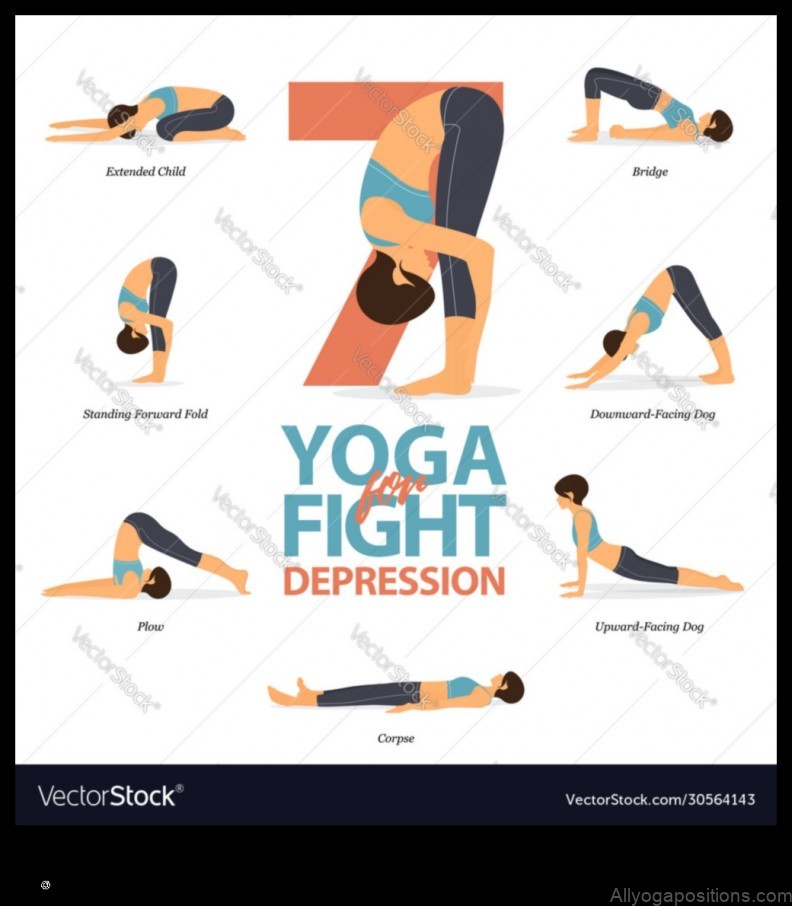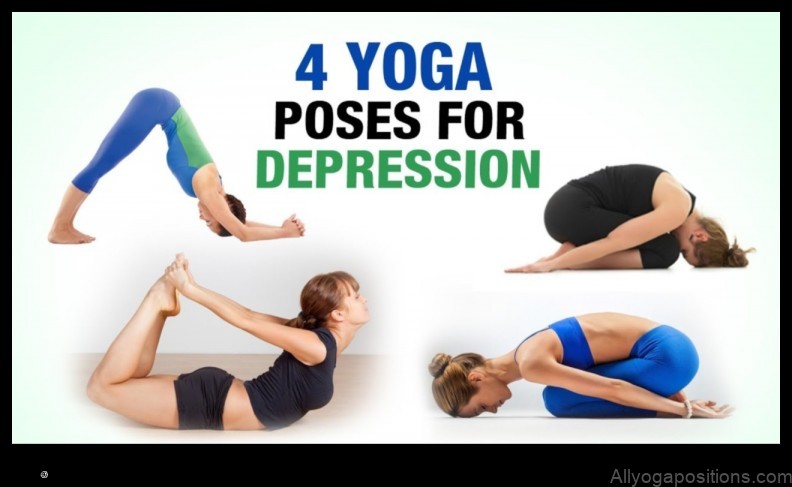
Yoga for Depression: Poses to Lift Your Spirits
Yoga is a mind-body practice that has been shown to have many benefits for people with depression, including reducing stress, improving mood, and increasing mindfulness.
If you are struggling with depression, yoga can be a helpful addition to your treatment plan. It can help you to manage your symptoms and improve your overall well-being.
This article will provide you with an overview of the benefits of yoga for depression, as well as specific poses that you can try to help lift your spirits.

Benefits of Yoga for Depression
Yoga has been shown to have a number of benefits for people with depression, including:
- Reduced stress
- Improved mood
- Increased mindfulness
- Improved sleep
- Reduced pain
- Improved flexibility
- Increased strength
Yoga can help to improve your mood by reducing stress and anxiety, and by increasing your sense of well-being. It can also help you to focus on the present moment and to let go of negative thoughts and feelings.
Yoga can also help to improve your sleep quality by reducing stress and anxiety, and by helping you to relax. When you are well-rested, you are better able to cope with the challenges of depression.
Yoga can also help to improve your flexibility and strength, which can give you a sense of accomplishment and boost your self-esteem.
Yoga Poses for Depression
There are many different yoga poses that can help to relieve the symptoms of depression. Some of the most helpful poses include:
- Child’s pose
- Forward fold
- Downward-facing dog
- Seated twist
- Bridge pose
- Plow pose
- Shavasana
These poses can help to stretch your muscles, improve your circulation, and reduce stress and anxiety. They can also help you to focus on the present moment and to let go of negative thoughts and feelings.
If you are new to yoga, it is important to start slowly and gradually increase the intensity of your practice as you become more comfortable. It is also important to listen to your body and to stop if you feel pain.

How to Do Yoga for Depression
When you are doing yoga for depression, it is important to focus on the following:
- Slow and controlled movements
- Deep breathing
- Mindfulness
Slow and controlled movements can help to reduce stress and anxiety, and to improve your flexibility and strength. Deep breathing can help to oxygenate your blood and improve your mood. Mindfulness can help you to focus on the present moment and to let go of negative thoughts and feelings.
To practice yoga for depression, you can follow these steps:
- Find a quiet place where you will not be disturbed.
- Start by sitting in a comfortable position and close your eyes.
- Take a few deep breaths and focus on your breath.
- Begin to move slowly and gently, paying attention to how your body feels.
- As you move, focus on your breath and on the present moment.
- If you feel pain, stop and rest.
- When you are finished, lie down in savasana and relax for a few minutes.
It is important to practice yoga for depression on a regular basis to see the benefits. Try to practice yoga for at least 30 minutes, three times per week.
Tips for Beginners
If you are new to yoga, here are a few tips to help you get started:
- Start slowly and gradually increase the intensity of your practice as
Topic Answer Yoga for Depression Yoga is a mind-body practice that has been shown to have many benefits for people with depression, including reducing stress, improving mood, and increasing mindfulness. Depression Depression is a mental health disorder that causes a person to feel sad, hopeless, and worthless. It can also lead to difficulty sleeping, loss of appetite, and difficulty concentrating. Anxiety Anxiety is a feeling of worry or nervousness that can be mild or severe. It can cause physical symptoms such as sweating, trembling, and difficulty breathing. Mindfulness Mindfulness is a state of being aware of the present moment without judgment. It can be practiced through meditation, yoga, and other activities. Stress Relief Stress is a feeling of pressure or tension that can be caused by a variety of factors, such as work, school, or relationships. It can lead to physical symptoms such as headaches, muscle aches, and fatigue. II. What is Yoga?
Yoga is a mind and body practice with a 5,000-year history in ancient Indian philosophy. It combines physical postures, breathing exercises, and meditation or relaxation.
Yoga is often practiced for its physical benefits, such as increased flexibility, strength, and balance. However, yoga can also have a number of mental and emotional benefits, including reducing stress, anxiety, and depression.
Yoga can help to improve mood by increasing serotonin and dopamine levels in the brain. These neurotransmitters are associated with feelings of happiness and well-being.
Yoga can also help to reduce stress by teaching relaxation techniques and providing a sense of calm and peace.
In addition, yoga can help to improve sleep quality, which can also help to reduce stress and depression.
III. Benefits of Yoga for Depression
Yoga has been shown to have a number of benefits for people with depression, including:
- Reduced stress and anxiety
- Improved mood
- Increased energy levels
- Improved sleep quality
- Enhanced self-awareness
- Increased flexibility and strength
Yoga can also help to improve your overall sense of well-being and can help you to cope with the challenges of depression.
IV. Yoga Poses for Depression
There are many different yoga poses that can help with depression. Some of the most beneficial poses include:
- Child’s pose
- Forward fold
- Standing forward bend
- Warrior II pose
- Bridge pose
- Savasana (corpse pose)
These poses can help to relieve stress, improve mood, and increase energy levels. They can also help to improve flexibility, strength, and balance.
It is important to listen to your body and modify the poses as needed. If you feel pain or discomfort, stop the pose and try a different one.
Yoga is a safe and effective way to help manage depression. It can be done at home or in a studio. If you are interested in trying yoga for depression, talk to your doctor or a qualified yoga instructor.
V. How to Do Yoga for Depression
Yoga is a mind-body practice that combines physical postures, breathing exercises, and meditation. It can be helpful for people with depression because it can:
- Reduce stress and anxiety
- Improve mood and energy levels
- Increase self-awareness and mindfulness
- Promote relaxation and sleep
If you are interested in trying yoga for depression, it is important to find a class that is appropriate for your fitness level and needs. You should also talk to your doctor before starting any new exercise program.
Here are some tips for doing yoga for depression:
- Start slowly and gradually increase the intensity of your practice over time.
- Listen to your body and stop if you feel pain.
- Practice yoga in a supportive environment.
- Make time for relaxation and meditation after your yoga practice.
Yoga can be a helpful addition to your treatment plan for depression. If you are interested in trying yoga, talk to your doctor or a qualified yoga instructor.
VI. Tips for Beginners
If you are new to yoga, there are a few things you can do to make your experience more enjoyable and beneficial.
- Start slowly and gradually increase the intensity of your practice over time.
- Listen to your body and don’t push yourself too hard.
- Find a yoga teacher who is knowledgeable about yoga for depression and can help you modify poses as needed.
- Practice yoga in a supportive environment where you feel comfortable.
- Make yoga a part of your overall treatment plan for depression.
VII. Common Myths About Yoga for Depression
There are many myths about yoga for depression that can prevent people from trying it. Here are some of the most common myths, and the truth behind them:
-
Yoga is only for flexible people.
This is not true! Yoga is for everyone, regardless of your flexibility level. There are many poses that are suitable for beginners, and you can always modify poses to make them more comfortable for you.
-
Yoga is a religion.
Yoga is not a religion. It is a practice that has been around for thousands of years, and it has roots in Hinduism and Buddhism. However, yoga can be practiced by people of all religions, or no religion at all.
-
Yoga is too expensive.
Yoga can be expensive, but it doesn’t have to be. There are many free yoga classes available online and in your community. You can also find affordable yoga classes at gyms, community centers, and yoga studios.
-
Yoga is only for women.
Yoga is for everyone, regardless of your gender. In fact, yoga can be especially beneficial for men, as it can help to improve strength, flexibility, and balance.
If you’re thinking about trying yoga for depression, don’t let these myths hold you back. Yoga is a safe and effective way to manage depression, and it can be enjoyed by people of all ages, genders, and religions.
Safety Precautions
When practicing yoga for depression, it is important to take some safety precautions. These include:
- Start slowly and gradually increase the intensity of your practice over time.
- Listen to your body and stop if you feel pain or discomfort.
- Stay hydrated by drinking plenty of water before, during, and after your practice.
- Avoid practicing yoga if you are feeling dizzy, lightheaded, or have a fever.
- Consult with your doctor before starting a yoga practice if you have any underlying health conditions.
IX. Resources for Yoga for Depression
Here are some resources that you may find helpful if you are interested in learning more about yoga for depression:
- Yoga Journal: Yoga for Depression
- WebMD: Yoga for Depression
- Mayo Clinic: Yoga for Depression
- HelpGuide.org: Yoga for Depression
- VerywellMind: Yoga for Depression
FAQ
Q: What is yoga?
A: Yoga is a mind and body practice with a 5,000-year history in ancient Indian philosophy. It combines physical postures, breathing exercises, and meditation or relaxation.
Q: What are the benefits of yoga for depression?
A: Yoga has been shown to have a number of benefits for people with depression, including reducing stress, improving mood, and increasing mindfulness.
Q: What are some yoga poses for depression?
A: Some yoga poses that can be helpful for depression include:
- Child’s pose
- Downward-facing dog
- Plow pose
- Savasana
Table of Contents
Maybe You Like Them Too
